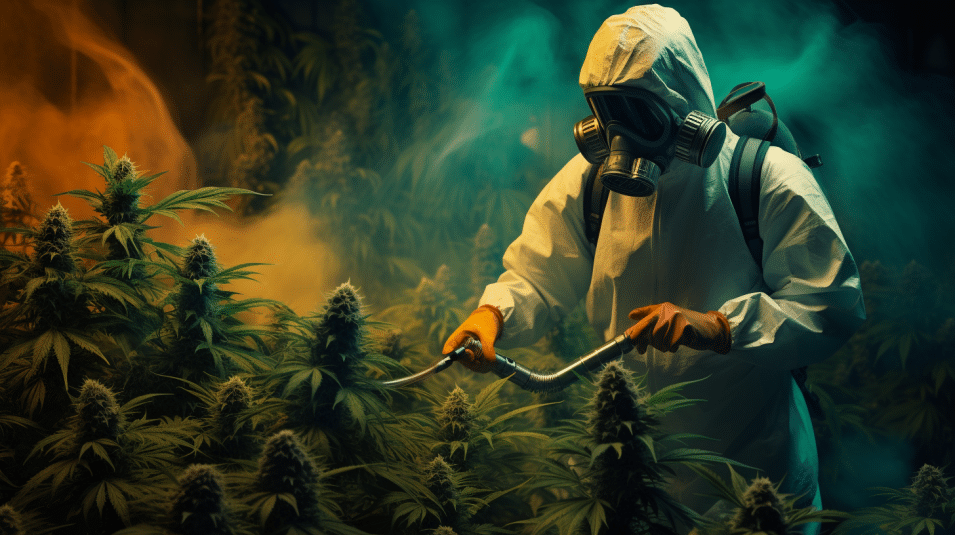A new Canadian study reveals that illicit cannabis contains concerning levels of pesticides, while legal cannabis products meet health safety standards.
Key Facts:
- The study tested 327 different pesticides in legal and illegal dried cannabis samples from across Canada.
- 92% of illegal samples contained pesticides, compared to just 6% of legal samples.
- Illegal cannabis contained over 3 different pesticides per sample on average.
- Three pesticides were found at levels up to 3000 times higher than safe limits in illegal cannabis.
- Legal cannabis met pesticide regulations, indicating the legal system improves safety.
Source: J Cannabis Res 2023
The Dangers of Pesticides in Cannabis
When cannabis is grown illegally without regulation, there is a high risk of pesticides being misused to increase yields.
Pesticides are toxic chemicals designed to kill living organisms, and their health impacts depend on the levels consumed.
Many pesticides allowed on food crops are not safe to inhale, especially at higher concentrations.
Studies have linked illicit cannabis contaminated with pesticides like myclobutanil to dangerous side effects including lung inflammation, breathing issues, and toxicity.
There are also concerns that pesticides may interact with cannabis compounds to produce more harmful effects. When cannabis is legalized, pesticide regulations are implemented to protect public health.
Testing for Pesticides in Canadian Marijuana
In 2018, Canada legalized recreational cannabis and put regulations in place to ensure product safety and consistency.
One requirement is that licensed producers demonstrate no unauthorized pesticides are present above trace amounts in their products.
This recent study developed an advanced method to test for 327 different pesticide residues in dried cannabis flower, the most commonly consumed cannabis product.
They applied this test to 36 legal cannabis samples from licensed producers across Canada and 24 illegal samples seized by police.
High Pesticide Levels Found in Illegal Marijuana
The results clearly show major differences in pesticide levels between legal and illegal cannabis.

- 92% of illegal samples tested positive for unauthorized pesticides, compared to just 6% of legal samples.
- On average, illegal samples contained 3.7 different pesticides each. One sample contained 9 types.
- 23 different pesticides were found in illegal cannabis, including dangerous insecticides and fungicides.
- Chlorpyrifos, imidacloprid and myclobutanil were found at levels up to 3000 times higher than permitted safety limits.
In contrast, legal cannabis met Canadian regulations, with only trace amounts of two pesticides detected right at the minimum detection limit in 2 samples.
This demonstrates that the legal cannabis system improves safety by prohibiting dangerous pesticides.
Consuming illegally grown cannabis without safety testing exposes users to multiple toxic chemicals at unsafe levels.
The Need for Advanced Pesticide Testing
These results highlight the importance of using advanced multi-residue pesticide testing methods capable of detecting hundreds of chemicals simultaneously.
Canada currently mandates testing for 96 prohibited pesticides, but this study shows illegal growers use additional dangerous and banned pesticides that would go undetected without expanded testing capabilities.
Advanced methods like this allow regulators to identify risks from illegal cannabis and make informed decisions to improve public health protections.
Comprehensive testing also provides valuable data to support the benefits of legalizing cannabis and directing consumers towards regulated products meeting safety standards.
Conclusion: Legal Cannabis is Safer
This first nationwide comparison of pesticide residues in legal versus illegal Canadian cannabis products clearly demonstrates the advantages of the regulated legal cannabis market in improving consumer safety.
Legal cannabis was overwhelmingly compliant with pesticide regulations, while illegal cannabis was contaminated with a diverse array of toxic pesticides at dangerously high levels.
These results support public health messaging that consuming legal cannabis is much safer than unregulated illegal products.
Comprehensive testing will continue to monitor risks and enhance protections as the new legal cannabis industry advances.
References
- Study: High levels of pesticides found in illicit cannabis inflorescence compared to licensed samples in Canadian study using expanded 327 pesticides multiresidue method
- Authors: Mathieu Gagnon et al. (2023)







